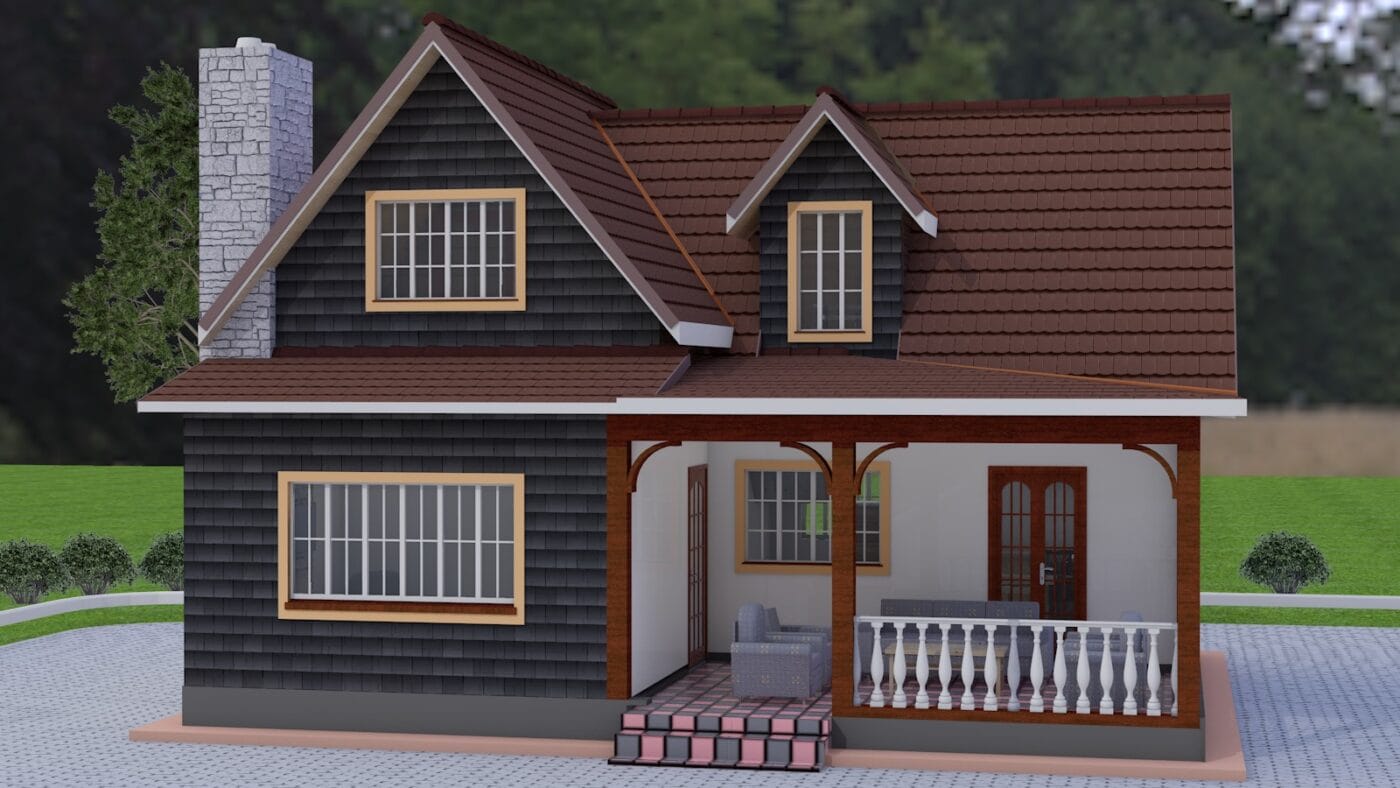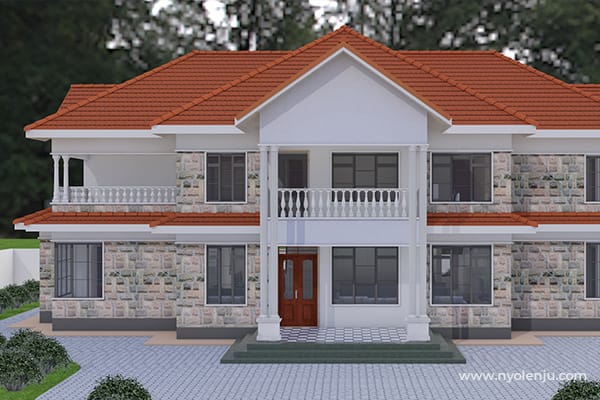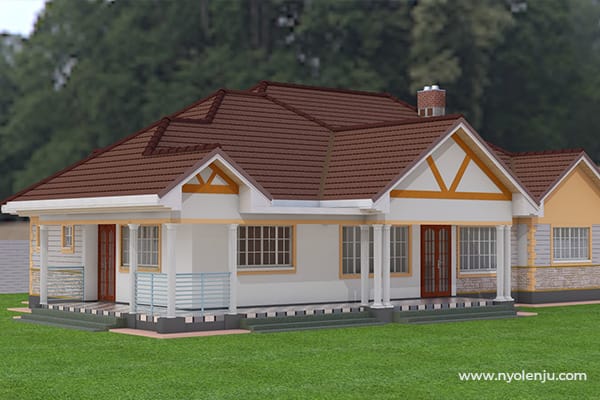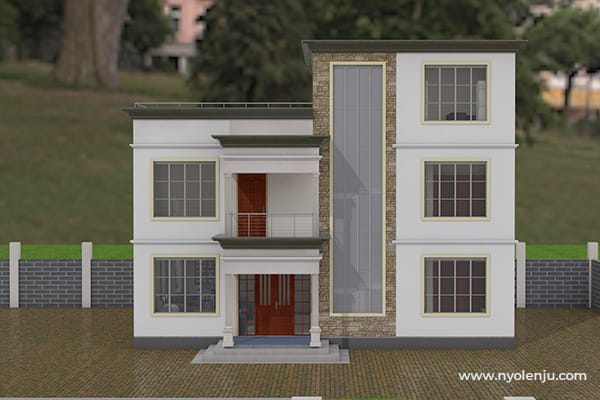Architecture, House Plans
10 Essential Features of Sustainable Home Designs
Get well informed on the 10 essential features of sustainable home designs. Green homes offer a significant way to reduce residential carbon emissions, which make up about 20% of worldwide greenhouse gases. Smart design meets modern technology in these eco-conscious homes to optimize comfort while reducing environmental effects. Homeowners now prioritize building using sustainable home designs to lower their ecological footprint and energy bills.
Leading Trends in Sustainable Home Design
As sustainability shapes the future of residential architecture, homeowners and builders are turning toward innovative trends that balance eco-responsibility with everyday comfort. Let’s explore the key trends that are redefining sustainable homes around the world:
1. Natural and Renewable Building Materials
Sustainable home design begins with thoughtful material choices. Expect to see more bamboo floors, cork wall panels, rammed earth, recycled timber, and natural stone in contemporary green homes. These materials not only lower environmental impact but also lend warmth and character. Classic options like reclaimed bricks or repurposed timber furniture also find new life, minimizing waste and celebrating craftsmanship.
2. Prefabrication and Modular Construction
Efficiency and sustainability are tightly linked, which is why prefabricated and modular homes are gaining traction globally. By building components off-site and assembling them on location, construction waste plummets and energy usage falls—plus, your house comes together much faster. Companies from Scandinavia to Silicon Valley are making prefab homes sleeker, smarter, and more adaptable than ever.
3. Creative Reuse and Upcycling
Why buy new when reused materials offer both character and a smaller carbon footprint? Salvaged metal, reclaimed wood, and even old shipping containers find fresh purpose as integral elements of eco-friendly homes. The result: less waste heading to landfills and a home brimming with history.
4. Indoor Green Spaces
Bringing nature indoors goes far beyond the humble houseplant. From living walls to kitchen herb gardens, these verdant touches naturally purify air, enhance wellbeing, and—if you’re growing produce—reduce your food miles. In some designs, lush planting zones double as room dividers or natural insulation.
5. Solar Solutions and Renewable Energy
Solar panels have become a hallmark of eco-conscious design. Advances in photovoltaic tech mean rooftops everywhere, from Melbourne to Minneapolis, are quietly capturing rays and slashing energy bills. Paired with energy storage and smart meters, solar helps make homes nearly self-sufficient.
6. Smart Water Conservation
As droughts become more frequent globally, water-wise design is now essential. Rainwater harvesting systems, greywater recycling, permeable paving, and low-flow fixtures can dramatically cut household water use. Savvy smart home water monitors even detect leaks before you spot them.
7. Green Roofs and Living Walls
Vegetated roofs and vertical gardens don’t just look good—they help insulate homes, absorb excess stormwater, and provide habitat for birds and pollinators. City dwellers, in particular, appreciate how these features buffer heat and add precious greenspace in dense neighborhoods.
8. Intelligent Home Technology
Smart thermostats, app-controlled lighting, and automated irrigation systems keep energy and water use efficient without sacrificing comfort. By tailoring systems to your routines, these gadgets help shave dollars off bills and contribute to sustainability goals with minimal fuss.
9. Efficient Appliances
Appliances bearing Energy Star or similar ratings are becoming standard fare, as people seek to cut long-term costs and environmental impact. From induction cooktops to heat pump dryers, efficient upgrades make a measurable dent in both electricity use and emissions.
10. Flexible, Multi-Use Spaces
Finally, less is more: smaller homes, open floor plans, and convertible furniture help homeowners get more from every square foot. Fewer rooms to heat, cool, and maintain translate directly into lower energy bills and a lighter carbon footprint.
Collectively, these trends don’t just make homes less harmful for the planet—they also offer warmth, comfort, and ingenuity for a new chapter in residential living.
A sustainable house needs several key features to work effectively. Natural lighting through strategic placement, efficient HVAC systems, and intelligent water conservation methods make these homes stand out. Every component plays a specific role in creating an eco-friendly living space – from solar panels and rainwater collection to proper insulation and green roofs. Integrating features like green walls and roofs not only enhances a home’s visual appeal but also provides tangible environmental benefits. These living structures help regulate indoor temperatures, reduce stormwater runoff, and combat the urban heat island effect—all while extending the lifespan of roofing materials and lowering heating and cooling costs.
In addition, green roofs and walls introduce unique natural elements to the structure, helping the house blend seamlessly with its surroundings and supporting local biodiversity by offering habitats for birds and insects. Collectively, these features work in harmony to create homes that are sustainable, comfortable, and connected to nature.
This piece highlights ten key features that help homeowners build environmentally responsible yet practical, sustainable homes.
Prefabrication: Fast-Tracking Sustainable Home Construction
Prefabrication—often called modular construction—is an innovative technique that’s gaining traction in the world of sustainable home designs. At its core, this process involves manufacturing building components in a controlled factory setting, then transporting these completed sections to the building site for final assembly. Think of it as putting together a giant Lego set, but for grown-ups (and with a much greener twist).
But how does prefabrication support a more sustainable future? Here’s where it really shines:
- Reduced Construction Waste: Since each part is precisely engineered in a factory, there’s far less material wasted compared to traditional on-site building methods.
- Quicker Build Times: Prefabricated homes can be erected much faster—meaning less time dealing with noise, dust, and disruption on-site.
- Lower Environmental Impact: The streamlined building process reduces the disturbance to the surrounding land and community, keeping construction footprints small.
- Energy Savings: Homes built this way are typically more airtight and energy-efficient, leading to decreased heating and cooling costs in the long run.
- Improved Worker Safety: Factory settings offer safer, more predictable work environments compared to open construction sites.
A notable example is the rural housing designed by Carlo Ratti Designs in Bangalore, which showcases just how efficient and eco-friendly prefabrication can be.
Prefabrication often goes hand in hand with tools like Building Information Modeling (BIM), allowing for even greater precision and efficiency. This approach not only accelerates the path to eco-living but also ensures that sustainable home designs are accessible, affordable, and built to last.
Leading Organizations in Green Building Ratings
Several global organizations set the benchmarks for what makes a building truly green. These groups assess the environmental impact and overall sustainability of homes and commercial spaces, offering standardized rating systems that help guide design and construction.
Some of the most recognized authorities in this space include:
- LEED (Leadership in Energy and Environmental Design): A widely adopted certification system originating from the U.S., LEED rewards projects for innovative and environmentally responsible building strategies.
- BREEAM (Building Research Establishment Environmental Assessment Method): Developed in the UK, BREEAM is one of the oldest green building rating systems, focusing on sustainability across a building’s entire life cycle.
- Green Star: Popular in Australia, Green Star rates buildings based on energy efficiency, water conservation, and materials used.
- GRIHA (Green Rating for Integrated Habitat Assessment): An Indian standard, GRIHA emphasizes resource efficiency and environmental stewardship in construction and operation.
These organizations serve as a compass for architects, builders, and homeowners aspiring to create spaces that are not only comfortable and energy-efficient but also tread lightly on the planet. Each provides a transparent framework to evaluate, compare, and improve the sustainability of building projects worldwide.
How to Develop Sustainable Home Designs: Passive Design Principles
Passive design principles are the foundations of sustainable home designs architecture. These principles work naturally with environmental elements to create energy-efficient spaces. These designs use environmental factors to keep spaces comfortable while reducing dependency on mechanical systems.
Site Planning and Orientation. The way a building faces the sun is the lifeblood of passive solar design. Buildings that face the sun properly can save significant energy even without extra solar features. Energy savings typically range from 10-20%, and heating costs can drop by up to 40% in some cases. The best results come from positioning a building’s longest side east-west to maximize southern exposure during winter. This setup captures natural warmth and creates opportunities for effective summer shading.
Natural Ventilation. Smart ventilation designs eliminate mechanical system requirements while delivering excellent indoor air quality. When positioned strategically, window placement, vents, and openings aid air movement throughout the building. The benefits are clear:
- Better indoor air quality through constant air exchange
- Lower energy use from mechanical systems
- More comfortable temperatures through natural cooling
- Less humid living spaces
Thermal Mass for Temperature Regulation
Thermal mass helps maintain steady indoor temperatures by storing and releasing heat energy. Materials like concrete, brick, and stonework are natural temperature controllers because of their high thermal mass properties. During the day, these materials soak up solar heat and release it slowly when temperatures drop, creating a balanced indoor climate. Material choice and placement within the building structure determine how well thermal mass works. This process combines building orientation and ventilation to create the best temperature control.
Eco-Friendly Materials for Sustainable Homes
Choosing sustainable and natural materials is another cornerstone of environmentally conscious house design. Flooring options such as bamboo and cork offer renewable, durable alternatives to traditional hardwoods and can also be used creatively in furniture and wall accents. For walls, materials like rammed earth, hempcrete, straw bales, and recycled wood not only reduce environmental impact but also enhance insulation and indoor air quality. When it comes to roofing, recycled metal, natural slate, clay or concrete tiles, and wooden shakes or shingles are all effective choices. These eco-friendly options help minimize energy consumption throughout the home’s lifecycle and support a healthier, more resource-efficient living environment.
Selecting the right materials—paired with thoughtful placement for thermal mass—forms the backbone of a sustainable, comfortable house that stands the test of time.
Smart Home Strategies for Better Efficiency
Smart home strategies play a crucial role in driving sustainability and cutting down on resource consumption. By harnessing the latest in smart technology, green homes achieve a new level of precision when it comes to comfort, efficiency, and overall performance.
Intelligent Climate Control. Smart thermostats, like those from ecobee or Nest, take the guesswork out of temperature management. They learn your routines, automatically adjusting heating and cooling—not only keeping your home cozy but also minimizing wasted energy. This approach can shave a noticeable amount off heating and cooling costs while reducing your carbon footprint.
Adaptive Lighting Solutions. Gone are the days of leaving lights on unnecessarily. Smart lighting controlled by motion sensors and timers ensures rooms are bright only when in use. This principle, widely adopted in sustainable building, adds up to impressive electricity savings over time while lowering overall demand from the grid.
Water Use Monitoring. With the help of advanced water metering and irrigation controllers (think Rachio or Hydrawise), modern homes can track every drop and optimize when and how plants are watered. Catch leaks early, prevent overwatering, and see real-time usage data to make informed choices that protect both your wallet and the environment.
When integrated thoughtfully, these smart systems transform a house into an eco-conscious living space—making green living simpler and more accessible for today’s homeowner.
How to Develop Sustainable Home Designs: Renewable Energy Integration
Today’s environmentally responsible houses are adding renewable energy systems to become energy-independent and minimize their environmental footprint. Multiple renewable sources work together to create a robust, quick energy ecosystem for homeowners.
Solar Power Systems. Recent solar panels have made the most important breakthroughs in efficiency, which makes them a practical choice for homes of all types. These systems convert more energy into power and come with sleek, all-black finishes that blend naturally with different roofing materials. Solar technology can cut monthly electricity costs dramatically or eliminate them. Many homeowners save up to 50% on energy bills.
Key benefits of integrated solar systems include:
- Reduced greenhouse gas emissions
- Long-term cost savings
- Better property value
- Energy independence
Geothermal Heating and Cooling. Geothermal heat pumps (GHPs) utilize the earth’s steady temperature (40°-70°F) to heat and cool homes efficiently. These systems provide heating, cooling, and hot water at higher efficiency rates than traditional HVAC systems. Geothermal systems last a long time – interior components work for up to 24 years while ground loops continue functioning for over 50 years.
Wind Energy Options. Wind Power offers an affordable renewable energy solution for homes in suitable locations. Slight wind electric systems can cut electricity bills by 50-90% annually. The original costs range from $15,000 to $50,000 per installation, but these systems provide excellent returns over time. Smaller roof-mounted turbines can add power to existing energy sources in urban and suburban areas, while rural properties benefit from larger, free-standing installations.
Homeowners can get the best results by combining multiple renewable sources in their sustainable home designs. A hybrid system that uses solar, wind, and geothermal technologies will provide a steady power supply in different weather conditions and seasons. This all-encompassing approach delivers reliable energy while maximizing efficiency and environmental benefits.
Eco-Friendly Water Management
Water management is the lifeblood of environmentally responsible housing design. Innovative solutions can dramatically reduce water consumption while preserving this vital resource. Today’s eco-friendly homes feature complete water management systems that conserve water and minimize environmental effects.
Water-Efficient Appliances
Water-efficient appliances are the foundations of sustainable home designs for water usage. Energy Star dishwashers use only 258 kWh per year, costing just $34 annually. These smart appliances don’t need pre-washing or rewashing, which reduces water waste significantly. Modern eco-friendly washing machines and dishwashers with WaterSense certification have shown excellent results by cutting water consumption while maintaining their cleaning power.
Benefits of Water- and Energy-Efficient Appliances
Choosing energy- and water-efficient appliances in eco-friendly homes delivers several compelling advantages:
- Lower greenhouse gas emissions: Reduced energy and water use means fewer emissions from power plants and less strain on municipal water systems.
- Water conservation: Advanced technologies save thousands of gallons per year without sacrificing performance.
- Cost savings: Lower utility bills quickly add up, making these appliances a smart long-term investment.
- Smaller carbon footprint: Each efficient appliance choice helps reduce your home’s overall environmental impact.
By integrating these innovative appliances, homeowners can minimize waste, conserve resources, and support a healthier, more sustainable lifestyle.
Drought-Resistant Landscaping
Modern sustainable green homes adopt xeriscaping principles to design water-wise outdoor spaces. Homeowners have achieved remarkable results, dropping water usage by up to 50% in outdoor areas. Drought-resistant landscaping offers several advantages:
- Less reliance on irrigation systems
- Minimal maintenance needs
- Better adaptation during water restrictions
- Natural spaces for local wildlife
Bluestem and purple fountain grass are beautiful ornamental options that help conserve water. Hardscaping elements with porous materials improve water absorption and minimize runoff.
Storm water Management
Green home infrastructure provides economical solutions to manage storm water runoff. The EPA reports that 10 trillion gallons of untreated storm water flow yearly into U.S. waterways. Modern environmentally responsible houses use innovative storm water systems that capture and reuse 75% of rooftop rainfall. These systems protect water quality through natural pollutant filtering and prevent flooding.
Bioretention cells and rain gardens act as natural filtration systems that clean contaminants before water flows into local waterways. Research shows that Wisconsin’s green infrastructure could capture or redistribute up to four billion gallons of storm water. California could save 4.5 trillion gallons. These numbers show how proper storm water management affects sustainable home designs.
Sustainable home Designs: Interior Design
Intelligent interior design choices create healthy, sustainable living spaces that complement eco-friendly architecture perfectly. Material selection, lighting systems, and air quality management substantially affect a home’s environmental footprint and its occupants’ well-being.
Non-Toxic Finishes and Furnishings
Modern green practices emphasize materials that protect environmental and human health. Studies reveal that traditional furniture manufacturing uses processes and materials that release dangerous VOCs into living spaces. Here are some sustainable alternatives used in sustainable home designs:
- Solid wood pieces with natural finishes
- Bamboo and woven reed furniture
- Ethically sourced natural-dyed leathers
- Organic fabrics for upholstery
Research shows that selecting non-toxic furniture is significant because these pieces are among the largest items in living spaces. Natural finishes showed better indoor air quality maintenance results since they contain no toxins or gases.
Sustainable Material Selection
A key pillar of sustainable interior design is the careful selection of materials that minimize environmental impact. This means choosing options that are renewable, locally sourced, recycled, or have low embodied energy—the total energy required to produce and transport the material. Common sustainable materials making their way into modern homes include:
- Bamboo and cork for flooring and accents
- Reclaimed wood from old barns or factories
- Recycled concrete for countertops and tiles
- Earth-based materials such as rammed earth or adobe for walls
By using these materials, homeowners not only reduce the environmental footprint of their interiors but also support healthier indoor air and more resilient, long-lasting design. Avoiding high-impact materials and opting for those that are responsibly sourced further amplifies a home’s sustainability profile.
Reused and Repurposed Materials
Incorporating reused or repurposed materials is a hallmark of thoughtful sustainable home design. By selecting resources like reclaimed wood beams, salvaged bricks, or repurposed metal, homeowners not only reduce landfill contributions but also conserve raw materials and energy that would be spent on manufacturing new products.
Designers often highlight salvaged materials as striking architectural elements—think exposed timber trusses from old barns or vintage brick incorporated into interior accent walls. These materials add rich texture and a sense of history to a home, all while supporting sustainability goals.
Some of the most practical reused materials include:
- Reclaimed wood for floors, cabinetry, and decorative wall panels
- Salvaged stone or bricks in walkways or fireplaces
- Second-life metal fixtures for railings and hardware
Cork is another excellent example: when sourced from sustainably managed forests, it provides durable, low-maintenance wall or floor finishes, adds valuable thermal insulation, and can be recycled again at the end of its lifespan. Using such materials not only minimizes resource extraction but often improves a home’s comfort and character.
Homeowners who prioritize reused and repurposed materials find unique beauty in every imperfection, knowing that every salvaged element represents a choice for a healthier planet.
Energy-Efficient Lighting
LED lighting technology has transformed eco-friendly indoor lighting and cuts energy use by up to 80% compared to traditional incandescent bulbs. These lights deliver better quality illumination and last 25 times longer than standard options.
Innovative design that brings in natural light helps reduce the need for artificial lighting. Research shows that well-planned daylighting approaches can cut energy costs by 20-60% compared to standard lighting systems. Intelligent lighting systems with occupancy sensors have shown extra energy savings of up to 35%.
Multi-Functional Spaces for Sustainable Living
Maximizing the versatility of interior spaces has become a cornerstone of sustainable home design. By incorporating multi-functional areas, homeowners are able to downsize square footage without sacrificing comfort or convenience—directly reducing material use, energy consumption, and overall environmental footprint.
Some practical strategies include:
- Convertible Furniture: Pieces like Murphy beds, expandable dining tables, and sleeper sofas allow a single room to serve as a home office by day and guest bedroom by night. This eliminates the need for redundant, seldom-used spaces.
- Open Floor Plans: Flexible layouts merge kitchens, dining, and living zones into unified spaces, naturally adapting to everyday and social needs. These configurations encourage shared lighting and heating, further reducing energy demands.
- Dual-Purpose Rooms: A media room can double as a gym, or a study can transform into a playroom for children, making each square foot work harder.
The result? Smaller homes with fewer resources required for construction and ongoing maintenance. When homeowners embrace adaptable room designs, it leads to less waste, lower utility bills, and, ultimately, a lighter environmental impact—without giving up style or functionality.
Indoor Gardens: Eco-Friendly and Practical Benefits
Indoor gardens go well beyond aesthetic value, making them a smart feature in today’s sustainable homes. Thoughtfully integrated plantings act as efficient natural air filters—absorbing carbon dioxide and increasing oxygen levels indoors. This creates a fresher, healthier environment and complements other indoor air quality measures.
In addition, indoor gardens help balance humidity, which enhances comfort and supports overall well-being. Homeowners are also incorporating edible varieties, such as herbs and leafy greens, to grow fresh produce year-round right at home. This approach not only supplies healthy ingredients but also trims the environmental impact linked with transporting food.
In short, indoor gardens are a versatile addition that supports both the health and sustainability goals of green home design.
Indoor Environmental Quality and Air Quality Improvements
Indoor air quality management plays a vital role today. Research reveals that people have created nearly 350,000 synthetic substances that could affect indoor environments. Modern eco-friendly houses now feature detailed air quality monitoring systems that track several key parameters:
- Particulate matter levels
- Volatile organic compounds
- Carbon dioxide concentrations
- Temperature and humidity
HEPA filters with booster fans and electrostatic precipitators have shown excellent results in improving air exchange rates. These monitoring systems have IoT capabilities that constantly track these parameters and allow quick adjustments to create ideal indoor environments.
But indoor environmental quality in sustainable home design goes even further. It’s not just about filtering the air—it’s about ensuring overall well-being. Proper ventilation strategies draw in fresh air and expel contaminants, while low-VOC paints, finishes, and adhesives minimize the release of harmful substances. Incorporating abundant natural light through well-placed windows and skylights decreases the need for artificial lighting and helps regulate circadian rhythms, creating healthier, more comfortable spaces.
Biophilic design, which connects occupants with nature by using natural materials, indoor plants, and views of green spaces, has also proven to enhance well-being. Plus, thoughtful attention to acoustic and thermal comfort ensures that these interiors are not only healthy but also peaceful and pleasant to inhabit.
By blending smart air quality management, responsible material choices, and holistic design strategies, sustainable homes deliver healthier, more uplifting living environments for everyone inside.
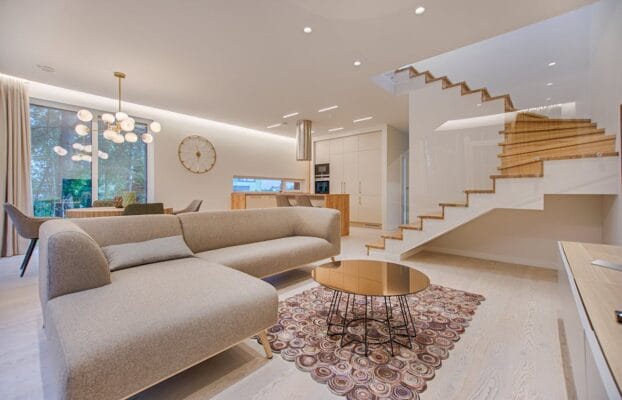
Conclusion
Sustainable home designs focus on creating environmentally responsible homes that integrate passive architecture, renewable energy systems, water conservation, and eco-friendly interiors. These features work together to reduce energy consumption by up to 40% through smart orientation and significantly cut water usage by 50% with innovative management systems. Additionally, advanced air quality controls help maintain healthier indoor environments. Modern sustainable home designs prove that eco-friendly living doesn’t have to compromise comfort, blending cutting-edge technologies with intelligent design principles.
As we confront the challenges of climate change and resource conservation, sustainable home designs play a crucial role in promoting environmental responsibility. These homes offer long-term benefits—lower utility bills, improved health outcomes, and increased property values. By incorporating green design elements when building new homes or renovating existing ones, homeowners can make a tangible impact, contributing to a more sustainable future.
Contact us today to design your dream house and become part of a growing movement that benefits current and future generations. You may also reach out to us through Facebook and WhatsApp.

